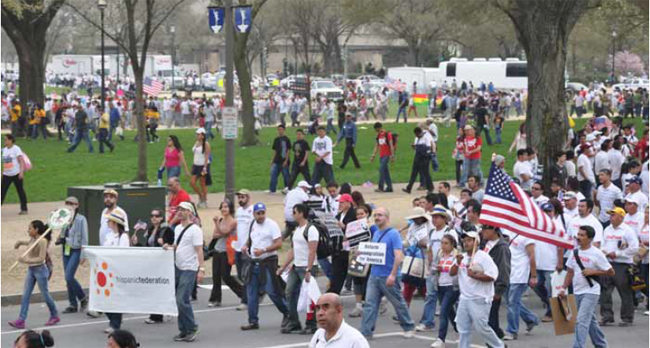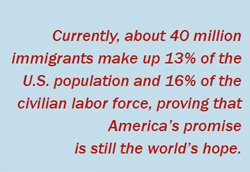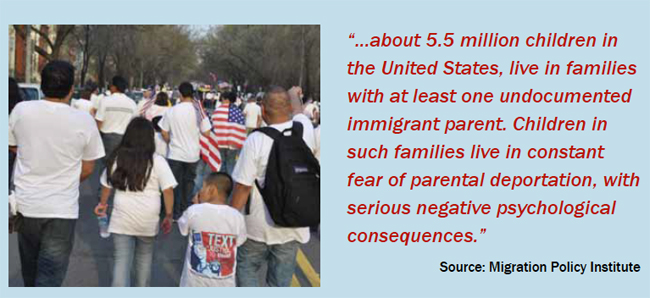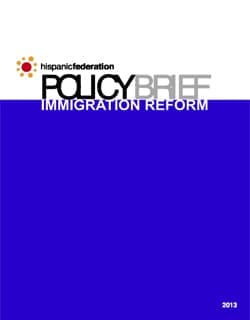PDF LINK Here: 2013 Policy Brief Immigration
A NATION OF IMMIGRANTS

We proudly proclaim America to be a “nation of immigrants.” Throughout our history, the U.S. has drawn people from all over the world to forge new lives, start and support families, and pursue their dreams. Currently, about 40 million immigrants make up 13% of the U.S. population. Then as now, immigration serves as a key force sustaining and driving America’s success. Immigrants have become essential workers in such diverse fields as construction, restaurants and hospitality, IT and health care. Some of the states widely considered to be U.S. “economic engines” — California, New York, Texas, New Jersey and Florida — are among the top five states with the largest number of immigrants. The Small Business Administration (SBA) states that immigrants are 30 percent more likely to start businesses than non-immigrants. These businesses created home-grown jobs for an estimated 4.7 million American workers in 2007.
Despite the importance of immigrants to our history and economy, there is broad consensus that our immigration system is irrevocably broken, plagued by visa backlogs, bureaucratic delays and outdated policies. The impact on families is incalculable. Millions of U.S. citizens and immigrants alike are forced to wait excruciatingly long periods before they are reunited with close family members.3 Latinos in the U.S. are disproportionately affected by these backlogs.4 Those wishing to sponsor an adult under the age of 21 from Mexico, for instance, sometimes have to wait more than 20 years before the application is processed.
Enforcement against immigrants, especially undocumented immigrants, has also taken its toll. Eight million undocumented immigrants are employed, composing 5 percent of the American workforce.5 Many own small businesses, contributing to the economy by creating jobs. The vast majority have lived in the U.S. for years and are tax-paying, law-abiding and productive members of society. Yet over the past decade the federal government has spent billions of dollars in enforcing border security and deportation policies. The result is that in 2011 and 2012 alone an astonishing 800,000+ immigrants were deported,
Section 287(g) initiatives, both which have turned local and state police into quasi-immigration officers, leading to a climate of racial profiling and fear on the part of all Americans who fit immigrant stereotypes. For example, the Immigration and Customs Enforcement agency (ICE) publicly characterizes Secure Communities as a deportation program which only targets serious criminals. Yet this portrayal is called into question by ICE’s own statistics. Reviews of actual records indicate that only a small percentage of those deported were convicted criminals. In the end, the “crime” for the vast majority of those deported was seeking safety or a better life in the U.S.7
Beginning in 2011, the Obama Administration attempted to shift the focus of immigration enforcement away from raids to a policy of prosecutorial discretion designed to reduce the deportation of “long time lawful residents.” Data indicates that there has been limited implementation of this policy by the Department of Homeland Security (DHS).8 On June 15, 2012, the White House also announced the Deferred Action for Childhood Arrivals (DACA) initiative, which provides a two-year administrative reprieve from deportation to undocumented young people. While these administrative actions are encouraging, they are no substitute for comprehensive reform.

The November 2012 victory of President Barack Obama, who ran on a pro-immigration reform platform and whose win was largely powered by an unprecedented wave of Latino voters, added a sense of political urgency to reform efforts. It has precipitated a bipartisan movement by Congressional leaders in both houses towards comprehensive immigration reform.
This movement must lead to action. The Hispanic Federation believes the time to pass a broad and inclusive immigration reform bill — a bill that protects the rights of every U.S. resident and ends the demonization of immigrants, particularly Latinos — is now. The Federation will judge the 113th Congress by its success in enacting comprehensive immigration reform. This Policy Brief serves as a blueprint for the principles we believe are needed to build a fair, just and equitable immigration system. If enacted, we are confident these reforms will serve the social and economic interests of our nation for many generations to come.

Why Now?
…Because the immigration system is broken and only comprehensive federal legislation can fix it.
- Family reunification is a significant concern for the Latino community due to backlogs that continue to plague our immigration system. Latinos sponsor 40 percent of all family-based immigrants. There are currently 4.5 million people in the family immigration backlog.9 As of February 2013, U.S. Citizenship and Immigration Services was processing some family-related visa applications filed as far back as June 1989. This is an intolerable situation for far too many families that demands immediate change.
- Each year, more than 350,000 people are incarcerated in detention centers, including people seeking asylum, legal residents, children, the mentally ill, and the chronically ill – sometimes in appalling conditions, often with no access to legal counsel. U.S. citizens and legal residents are being unlawfully jailed and in some cases even deported.
- Undocumented migrants remain in the shadows even if they have been in the U.S. for years or decades. A report from the Pew Hispanic Center estimates that nearly two-thirds of undocumented immigrants living in the United States have been in the country for at least ten years. Most fill key gaps in the labor market, but they often toil long hours for low wages in poor working conditions, marginalized from the rest of society and separated from their families. Temporary workers and other legal workers, often face similar workplace abuse.
- Families are being torn apart. Nearly 45,000 undocumented parents of U.S. citizen children were deported in the first six months of 2012, and at least 5,100 of their children now live in foster care in 22 states, creating considerable public cost and great human suffering.
- Only 8% of those detained through the Department of Homeland Security’s (DHS) Policy Brief on Immigration Reform mandatory Secure Communities “partnership” program have been charged with being removable following an aggravated felony conviction, according to one recent study. Most have been detained because they are believed to be undocumented or on other immigration grounds.
- An estimated 84% of individuals detained by the immigration enforcement system have no attorney.
- In the absence of federal legislation, more than 40 states have passed their own immigration laws, as have some municipalities. While a few protect immigrant rights or provide in-state tuition for DREAMers, the vast majority are anti-immigrant.
… Because failure to act leads to racial profiling and other violationsof the civil rights of Americans, including all Hispanics.
- State anti-immigrant laws like Arizona’s SB 1070 “virtually guarantee racial profiling, discrimination and harassment against all La
- As the largest and fastest growing ethnic group in the nation, Hispanics now total 53 million and make up 10% of the U.S. electorate.19 Latino population and voting power — projected to outpace all U.S. communities over the next twenty years — will only continue to grow.
- 93% of Latinos under the age of 18 are U.S. citizens, as are 74% of Latino adults (63% native born and 11% naturalized).
- Regardless of immigration status, every Latino in the United States can have his/her civil rights violated by states and localities engaging in legally sanctioned racial profiling, be held for days in a local jail without charge, and detained without due process.
…and because immigration brings great economic benefits.
- With an aging U.S. population, immigrant workers who typically arrive in their 20s will provide improvement to our nation’s dependency ratio (the proportion of children and retired people compared to economically active workers).
- People willing to risk coming to a new country are typically highly motivated and ready to work hard. Immigrants have a higher labor force participation rate than native-born Americans and the country will need the talent and sacrifice of both highly trained and less skilled workers.
- Immigrants often help the economy by starting new businesses. Immigrants make up 14% of the population but are 18% of small-business owners, together providing about 4.7 million jobs. During the 1990s, immigrants developed more than one-third of Silicon Valley high-tech start ups.
- Between 50% and 70% of the nation’s 1.2 million agricultural workers are undocumented, and U.S. citizens will not take such jobs, even in difficult economic times. According to Time Magazine (September 21, 2012),“acute labor shortages brought on by anti-immigration measures” passed by states such as Alabama, Arizona, and Georgia, threaten record losses, with the American Farm Bureau Federation predicting that “Nationwide, labor shortages will result in losses of up to $9 billion.”
- The libertarian Cato Institute predicted in 2012 that comprehensive immigration reform, including a path to citizenship for undocumented immigrants, “would yield at least $1.5 trillion in added GDP over 10 years as a result of increased consumption, job creation and additional tax revenue.”

